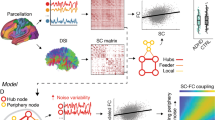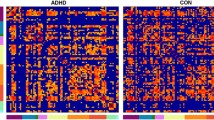Abstract
The role of network metrics in exploring brain networks of mental illness is crucial. This study focuses on quantifying a node controllability index (CA-scores) and developing a novel framework for studying the dysfunction of attention deficit hyperactivity disorder (ADHD) brains. By analyzing fMRI data from 143 healthy controls and 102 ADHD patients, the controllability metric reveals distinct differences in nodes (brain regions) and subsystems (functional modules). There are significantly atypical CA-scores in the Rolandic operculum, superior medial orbitofrontal cortex, insula, posterior cingulate gyrus, supramarginal gyrus, angular gyrus, precuneus, heschl gyrus, and superior temporal gyrus of ADHD patients. A comparison with measures of connection strength, eigenvector centrality, and topology entropy suggests that the controllability index may be more effective in identifying abnormal regions in ADHD brains. Furthermore, our controllability index could be extended to investigate functional networks associated with other psychiatric disorders.




Similar content being viewed by others
Availability of data and materials
The datasets of the current study are available at http://fcon_1000.projects.nitrc.org/indi/adhd200/index.html.
Code availability
The MATLAB code here is available from the corresponding author, Dr. Weigang Sun, upon reasonable request.
References
Agoalikum E, Klugah-Brown B, Yang H et al (2021) Differences in disrupted dynamic functional network connectivity among children, adolescents, and adults with attention deficit/hyperactivity disorder: A resting-state fMRI study. Front Hum Neurosci 15:697696
Ansari Nasab S, Panahi S, Ghassemi F et al (2022) Functional neuronal networks reveal emotional processing differences in children with ADHD. Cogn Neurodyn 16:91
Barber AD, Jacobson LA, Wexler JL et al (2015) Connectivity supporting attention in children with attention deficit hyperactivity disorder. Neuroimage Clin 7:68
Baribeau DA, Dupuis A, Paton TA et al (2019) Structural neuroimaging correlates of social deficits are similar in autism spectrum disorder and attention-deficit/hyperactivity disorder: Analysis from the POND Network. Transl Psychiatr 9:72
Bassett DS, Sporns O (2017) Network neuroscience. Nat Rev Neurosci 20:353
Broyd SJ, Demanuele C, Debener S et al (2009) Default-mode brain dysfunction in mental disorders: a systematic review. Neurosci Biobehav Rev 33:279
Bullmore E, Sporns O (2009) Complex brain networks: graph theoretical analysis of structural and functional systems. Nat Rev Neurosci 10:186
Cao XH, Cao QJ, Long XY et al (2009) Abnormal resting-state functional connectivity patterns of the putamen in medication-naive children with attention deficit hyperactivity disorder. Brain Res 1303:195
Carmona S, Vilarroya O, Bielsa A et al (2005) Global and regional gray matter reductions in ADHD: a voxel-based morphometric study. Neurosci Lett 389:88
Castellanos FX, Margulies DS, Kelly C et al (2008) Cingulate-precuneus interactions: a new locus of dysfunction in adult attention-deficit/hyperactivity disorder. Biol Psychiatry 63:332
Chaim TM, Zhang TH, Zanetti MV et al (2014) Multimodal magnetic resonance imaging study of treatment-naive adults with attention-deficit/hyperactivity disorder. PLoS ONE 9:e110199
Chen B (2019) Abnormal cortical region and subsystem complexity in dynamical functional connectivity of chronic schizophrenia: a new graph index for fMRI analysis. J Neurosci Methods 311:28
Chen B (2022) A preliminary study of abnormal centrality of cortical regions and subsystems in whole brain functional connectivity of autism spectrum disorder boys. Clin EEG Neurosci 53:3
Chen J, Sun WG, Wang J (2023) Topology design for leader-follower coherence in noisy asymmetric networks. Phys Scr 98:015215
Fair DA, Posner J, Nagel BJ et al (2010) Atypical default network connectivity in youth with attention-deficit/hyperactivity disorder. Biol Psychiatry 68:1084
Fernández-Jén A, López-Martín S, Albert J et al (2014) Cortical thinning of temporal pole and orbitofrontal cortex in medication-naive children and adolescents with ADHD. Psychiatr Res 224:8
Friedman LA, Rapoport JL (2015) Brain development in ADHD. Curr Opin Neurobiol 30:106
Gao YX, Shuai DD, Bu X et al (2019) Impairments of large-scale functional networks in attention-deficit/hyperactivity disorder: a meta-analysis of resting-state functional connectivity. Psychol Med 49:2475
Griffiths KR, Grieve SM, Kohn MR et al (2016) Altered gray matter organization in children and adolescents with ADHD: a structural covariance connectome study. Transl Psychiatr 6:e947
Gu S, Pasqualetti F, Cieslak M et al (2015) Controllability of structural brain networks. Nat Commun 6:8414
Hart H, Radua J, Nakao T et al (2013) Meta-analysis of functional magnetic resonance imaging studies of inhibition and attention in attention deficit/ hyperactivity disorder: Exploring task-specific, stimulant medication, and age effects. JAMA Psychiatr 70:185
Hoogman M, Muetzel R, Guimaraes JP et al (2019) Brain imaging of the cortex in ADHD: a coordinated analysis of large-scale clinical and population-based samples. Am J Psychiatry 176:531
Itami S, Uno H (2002) Orbitofrontal cortex dysfunction in attention-deficit hyperactivity disorder revealed by reversal and extinction tasks. NeuroReport 13:2453
Jamalabadi H, Zuberer A, Kumar VJ et al (2021) The missing role of gray matter in studying brain controllability. Netw Neurosci 5:198
Kalman RE (1963) Mathematical description of linear dynamical systems. J SIAM Control Ser A 1:152
Katsuki F, Constantinidis C (2014) Bottom-up and top-down attention: different processes and overlapping neural systems. Neuroscientist 20:5
Kim JZ, Soffer JM, Kahn AE et al (2018) Role of graph architecture in controlling dynamical networks with applications to neural systems. Nat Phys 14:91
Klein M, Souza-Duran FL, Menezes AKPM et al (2021) Gray matter volume in elderly adults with ADHD: associations of symptoms and comorbidities with brain structures. J Atten Disord 25:829
Lin CT (1974) Structural controllability. IEEE Trans Autom Control 19:201
Liu Y, Liang M, Zhou Y et al (2008) Controllability of complex networks. Brain 131:945
Liu YY, Slotine JJ, Barabási AL (2011) Controllability of complex networks. Nature 473:167
Long NM, Kuhl BA (2018) Bottom-up and top-down factors differentially influence stimulus representations across large-scale attentional networks. J Neurosci 38:10
Makris N, Biederman J, Valera EM et al (2007) Cortical thinning of the attention and executive function networks in adults with attention deficit/hyperactivity disorder. Cereb Cortex 17:1364
McCarthy H, Skokauskas N, Frodl T et al (2014) Identifying a consistent pattern of neural function in attention deficit hyperactivity disorder: a meta-analysis. Psychol Med 44:869
Mclaughlin KA, Sheridan MA, Winter W et al (2014) Widespread reductions in cortical thickness following severe early-life deprivation: a neurodevelopmental pathway to ADHD. Biol Psychiatry 76:629
Nakao T, Radua J, Rubia K et al (2011) Gray matter volume abnormalities in ADHD: Voxel-based meta-analysis exploring the effects of age and stimulant medication. Am J Psychiatry 168:1154
Park B, Park H (2016) Connectivity differences between adult male and female patients with attention deficit hyperactivity disorder according to resting-state functional MRI. Neural Regen Res 11:119
Power JD, Cohen AL, Nelson SM et al (2011) Functional network organization of the human brain. Neuron 72:665
Ruths J, Ruths D (2014) Control profiles of complex networks. Science 343:1373
Saad JF, Griffiths KR, Kohn MR et al (2017) Regional brain network organization distinguishes the combined and inattentive subtypes of attention deficit hyperactivity disorder. NeuroImage-Clin 15:383
Salavert J, Ramos-Quiroga JA, Moreno-Alcázar A et al (2018) Functional imaging changes in the medial prefrontal cortex in adult ADHD. J Atten Disord 22:679
Sathyanesan A, Zhou J, Scafidi J et al (2019) Emerging connections between cerebellar development, behaviour and complex brain disorders. Nat Rev Neurosci 20:298
Shang CY, Yan CG, Lin HY et al (2016) Differential effects of methylphenidate and atomoxetine on intrinsic brain activity in children with attention deficit hyperactivity disorder. Psychol Med 46:3173
Sizemore AE, Bassett DS (2018) Dynamic graph metrics: tutorial, toolbox, and tale. Neuroimage 180:417
Sörös P, Hoxhaj E, Borel P et al (2019) Hyperactivity/restlessness is associated with increased functional connectivity in adults with ADHD: a dimensional analysis of resting state fMRI. BMC Psychiatry 19:43
Sporns O, Zwi J (2009) The small world of the cerebral cortex. Neuroinformatics 2:145
Sripada C, Kessler D, Fang Y et al (2014) Disrupted network architecture of the resting brain in attention-deficit/hyperactivity disorder. Hum Brain Mapp 35:4693
Sun L, Cao QJ, Long XY et al (2012) Abnormal functional connectivity between the anterior cingulate and the default mode network in drug-na?ve boys with attention deficit hyperactivity disorder. Psychiatr Res 201:120
Sun WG, Li YF, Liu SY (2020) Noisy consensus dynamics in windmill-type graphs. Chaos 30:123131
Sutcubasi B, Metin B, Kurban MK et al (2020) Resting-state network dysconnectivity in ADHD: a system-neuroscience-based meta-analysis. World J Biol Psychiatry 21:662
Thapar A, Cooper M, Jefferies R et al (2012) What causes attention deficit hyperactivity disorder? Arch Dis Child 97:260
Tian LX, Jiang TZ, Wang YF et al (2006) Altered resting state functional connectivity patterns of anterior cingulate cortex in adolescents with attention deficit hyperactivity disorder. Neurosci Lett 400:39
Uddin LQ, Kelly AMC, Biswal BB et al (2008) Network homogeneity reveals decreased integrity of default-mode network in ADHD. J Neurosci Methods 169:249
Wu X, Kong X, Vatansever D et al (2022) Dynamic changes in brain lateralization correlate with human cognitive performance. PLoS Biol 20:3
Xia S, Foxe JJ, Sroubek AE et al (2014) Topological organization of the small-world visual attention network in children with attention deficit/hyperactivity disorder (ADHD). Front Hum Neurosci 8:162
Xiang LY, Chen F, Ren W et al (2019) Advances in network controllability. IEEE Circ Syst Mag 19:8
Yan G, Vértes PE, Towlson EK (2017) Network control principles predict neuron function in the Caenorhabditis Elegans connectome. Nature 550:519
Yang P, Wang PN, Chuang KH et al (2008) Absence of gender effect on children with attention-deficit/hyperactivity disorder as assessed by optimized voxel-based morphometry. Psychiatry Res 164:245
Yang H, Wu QZ, Guo LT et al (2011) Abnormal spontaneous brain activity in medication-naive ADHD children: a resting state fMRI study. Neurosci Lett 502:89
Yin WY, Li TF, Mucha PJ et al (2022) Altered neural flexibility in children with attention-deficit/hyperactivity disorder. Mol Psychiatry 27:4673
Yu XY, Yuan BK, Cao QJ et al (2016) Frequency-specific abnormalities in regional homogeneity among children with attention deficit hyperactivity disorder: a resting-state fMRI study. Sci. Bull. 61:682
Yuan J, Ji SQ, Luo L et al (2022) Control energy assessment of spatial interactions among macro-scale brain networks. Hum Brain Mapp 43:2181
Zepf FD, Bubenzer-Busch S, Runions KC et al (2019) Functional connectivity of the vigilant-attention network in children and adolescents with attention-deficit/hyperactivity disorder. Brain Cognit 131:56
Zhang DF, Xu D, Chen J et al (2022) Robustness of synchronizability in windmill networks with node failures. Int J Mod Phys B 36:2250098
Zhao QH, Li H, Yu XY et al (2017) Abnormal resting-state functional connectivity of insular subregions and disrupted correlation with working memory in adults with attention deficit/hyperactivity disorder. Front Psychiatry 8:200
Zhou Y, Wang K, Liu Y et al (2010) Spontaneous brain activity observed with functional magnetic resonance imaging as a potential biomarker in neuropsychiatric disorders. Cogn Neurodyn 4:275
Funding
This work was supported by Guangxi Key Laboratory of Trusted Software (No. KX202309).
Author information
Authors and Affiliations
Contributions
B.C., W.S. and C.Y. contributed to the conception and design of the study. B.C. and W.S. performed the numerical results. B.C., W.S. and C.Y. wrote the manuscript.
Corresponding author
Ethics declarations
Conflict of interest
The authors declare that they have no conflict of interest.
Ethical approval
All research was approved by the Research Ethics Review Board, the Institute of Mental Health, Peking University.
Additional information
Publisher's Note
Springer Nature remains neutral with regard to jurisdictional claims in published maps and institutional affiliations.
Supplementary Information
Below is the link to the electronic supplementary material.
Rights and permissions
Springer Nature or its licensor (e.g. a society or other partner) holds exclusive rights to this article under a publishing agreement with the author(s) or other rightsholder(s); author self-archiving of the accepted manuscript version of this article is solely governed by the terms of such publishing agreement and applicable law.
About this article
Cite this article
Chen, B., Sun, W. & Yan, C. Controllability in attention deficit hyperactivity disorder brains. Cogn Neurodyn (2024). https://doi.org/10.1007/s11571-023-10063-z
Received:
Revised:
Accepted:
Published:
DOI: https://doi.org/10.1007/s11571-023-10063-z




